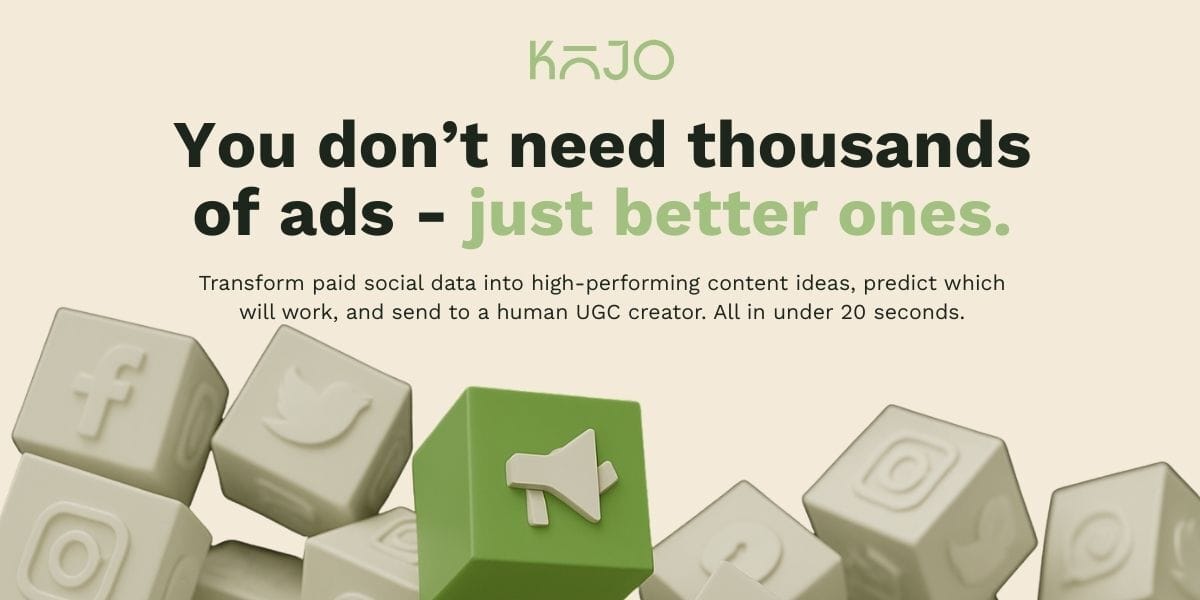- Social Media Growth Guide
- Posts
- Why People Share Content: 6 Viral Triggers That Work
Why People Share Content: 6 Viral Triggers That Work
Discover the psychology behind viral content. Learn 6 proven triggers that make people share posts on social media and boost your organic reach.
Ever wonder why some posts explode while others barely get a like? It's not luck. It's psychology.
This week, we're diving into the science of viral triggers—the hidden forces that make people hit that share button. By the end of this edition, you'll know exactly how to tap into these triggers to amplify your reach.
Find your next winning ad creative in seconds with AI
Most AI tools promise you thousands of ads at the click of a button. But do you really need more ads—or just better ones?
Kojo helps you cut through the noise. We analyze your paid social data to uncover the ideas with the highest chance of success. Then, our AI predicts which concepts will perform best, so you don’t waste budget testing what won’t work.
Instead of drowning in endless variations, Kojo sends your best idea straight to a real human creator who makes it engaging, authentic, and ready to win on social. The entire process takes less than 20 seconds, giving you certainty before you spend and better performance without the waste.
Why gamble on guesswork or settle for AI spam when you can launch ads proven to work, made by people, and backed by data?
1. High-Arousal Emotions
Content that sparks intense feelings gets shared more than anything else. We're talking about emotions that make people feel something deeply:
Awe & Inspiration: Think breathtaking transformations, incredible achievements, or mind-blowing facts
Humor & Amusement: Relatable memes, clever wordplay, or unexpected twists that make people laugh out loud
Anger & Outrage: Injustices, frustrations, or controversial takes (use carefully and authentically)
Surprise & Shock: Unexpected reveals, plot twists, or counter-intuitive insights
Action Step: Before posting, ask yourself: "What emotion does this trigger?" If the answer is "none," rework it.
People share content that makes them look good. It's that simple.
When someone shares your post, they're essentially saying, "This is what I stand for." Content that helps people:
Appear knowledgeable or "in the know"
Showcase their values and identity
Look funny, smart, or compassionate to their network
Action Step: Create content that makes your audience the hero. Frame insights as "insider tips" or exclusive knowledge they can share to elevate their status.
3. Practical Value
Useful content gets shared because people genuinely want to help others. The more actionable and immediately applicable, the better.
High-share content includes:
Step-by-step tutorials
Time-saving hacks
Money-saving tips
Problem-solving frameworks
Action Step: End every post with a clear takeaway. If someone can't immediately use or implement your content, add more practical value.
4. Storytelling & Relatability
Stories stick. Data doesn't. (Unless wrapped in a story.)
Personal narratives, case studies, and "I've been there" moments create emotional connections that facts alone can't match. When people see themselves in your content, they share it because it validates their own experiences.
Action Step: Replace statistics with mini-stories. Instead of "90% of businesses struggle with X," try "Last month, I watched three clients make the same costly mistake with X..."
5. Novelty & Uniqueness
Our brains are wired to notice what's different. New angles, fresh perspectives, or unique approaches cut through the noise.
Viral content often features:
Counterintuitive insights ("Everything you know about X is wrong")
Trend-jacking with original spins
Behind-the-scenes glimpses others don't show
Bold, contrarian opinions (backed by reasoning)
Action Step: For every piece of content, ask: "What's the unexpected angle here?" Challenge common assumptions in your niche.
6. Community & Participation
The most viral content invites interaction. It's not a broadcast—it's a conversation starter.
Think about:
Fill-in-the-blank posts
"Tag someone who..." prompts
Controversial questions that spark debate
Challenges or trends people can recreate
Action Step: Add a participation hook to every post. Questions, polls, challenges—anything that transforms viewers into contributors.
Here's how to combine these triggers:
Example Post Structure:
Hook with emotion (curiosity, surprise, or strong feeling)
Deliver practical value (teach something useful)
Make it relatable (add a personal story or example)
End with participation (ask a question or create a challenge)
Real Example: "I spent $5,000 on ads before learning this one algorithm hack [emotion: surprise + curiosity]. Now I get 10x the reach organically. Here's the 3-step framework [practical value]: [Framework details + personal story about discovering it]. What's your biggest organic growth challenge? Drop it below [participation]."
Avoid these share-killers:
❌ Being too salesy or self-promotional
❌ Vague or generic statements everyone's heard before
❌ No clear emotion or takeaway
❌ Content that's hard to understand quickly
❌ Making people feel bad about themselves without offering solutions
Your Weekly Challenge
Pick your best-performing post from the last month. Now rewrite it incorporating at least 3 of the viral triggers above. Post both versions and track the difference in engagement.
Remember: Viral content isn't about manipulation—it's about understanding human psychology and creating content that genuinely resonates.
That's a wrap!
Start your newsletter & monetize it
If you are serious about starting a newsletter & monetize it to be the master of your time, I highly recommend Beehiiv.


